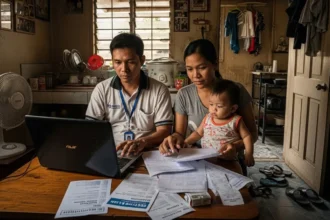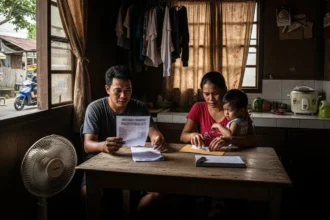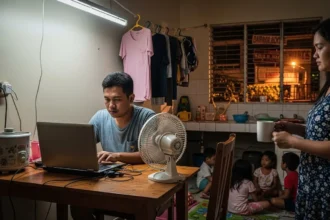Investing is no longer just for the wealthy. In the Philippines today, even ordinary workers, freelancers, and students can begin with just a few hundred pesos. The old belief that you need ₱100,000 or more to invest has been shattered by digital platforms and fintech apps. The opportunity to grow your money instead of just saving it is now more accessible than ever.
- 💡 What Does “Investing” Really Mean?
- 🏦 Types of Investments in the Philippines
- 📊 Table 1: Types of Investments in the Philippines
- 📚 Beginner-Friendly Investments
- 📈 Stocks: Owning a Piece of Companies
- 🏠 Real Estate: The Filipino Dream Investment
- 📊 Table 2: Minimum Investment Requirements (Philippines, 2025)
- ⚖ Risks Every Beginner Must Know
- 🌱 How to Start Investing in the Philippines (Step by Step)
- ❓ Frequently Asked Questions (FAQ)
- ✨ Final Reflection: Building Wealth the Filipino Way
- 📈 References
But here’s the problem: while more Filipinos are aware of investing, many are still afraid to take the first step. They worry about scams, losing money in the stock market, or simply not understanding where their money goes. This fear is understandable – after all, investing has risks. Yet what many don’t realize is that not investing also carries a risk: the slow erosion of your money’s value due to inflation.
In 2025, inflation continues to challenge household budgets. A peso saved in a low-interest bank account is worth less tomorrow. That’s why learning how to invest is no longer optional – it’s a necessity. With the right mindset, knowledge, and strategies, any Filipino can start building wealth, even with limited resources.
This guide will give you the basics of investing in the Philippines, the different options available, the risks you need to understand, and the practical steps to get started. By the end, you’ll see that investing isn’t something to fear – it’s something to master.
💡 What Does “Investing” Really Mean?
At its core, investing means putting your money into something that has the potential to grow in value over time. Unlike saving, where you simply set aside money in a bank account, investing involves a calculated risk in exchange for higher returns.
Key Differences Between Saving and Investing
- Saving: Low risk, low reward, money stays safe but grows slowly.
- Investing: Higher risk, higher reward, money can grow faster but may fluctuate.
Understanding this difference is the first step. As a beginner, you don’t need to jump into high-risk investments. You can start small, learn as you go, and gradually explore more complex options.
🏦 Types of Investments in the Philippines
There are many ways to grow your money in the Philippines, but not all investments are created equal. Each one has its own level of risk, accessibility, and potential return. To choose wisely, you need to understand how each type works and what kind of investor it’s best suited for.
Stock Market
The stock market lets you buy shares of companies like Jollibee, Ayala, or PLDT. When these companies grow, your shares can increase in value, and some even pay dividends. Stocks are considered medium- to high-risk because prices fluctuate daily. However, over the long term, they can offer higher returns than most other options. Beginners often start small through apps like COL Financial or GCash Stocks to get familiar without risking too much.
Mutual Funds / UITFs
For those who don’t want to pick stocks themselves, mutual funds and Unit Investment Trust Funds (UITFs) are great alternatives. These are pooled investments where professional fund managers handle your money along with thousands of others. You earn based on the performance of the entire fund. The entry point is low – sometimes as little as ₱1,000 – making it one of the most beginner-friendly investments in the country.
Bonds
Bonds are essentially loans you give to the government or big companies, and they pay you interest in return. For example, the Philippine government regularly issues Retail Treasury Bonds (RTBs) with a guaranteed interest rate. Bonds are considered low-risk, especially government-issued ones, making them ideal for conservative investors or those close to retirement. The downside is that returns are generally lower compared to stocks.
Real Estate
Filipinos have long viewed property ownership as a symbol of success. Investing in real estate can mean buying a condo to rent out, purchasing a lot to resell in the future, or even investing in commercial spaces. The potential returns are attractive, especially in growing cities, but the capital required is high – usually in the hundreds of thousands to millions of pesos. Liquidity is also a challenge since selling property takes time.
Digital Banks & Time Deposits
These options are low-risk and suitable for people who prefer safety over high returns. Digital banks like Tonik or Maya offer higher interest rates than traditional banks, sometimes reaching 6% annually. Time deposits, on the other hand, lock your money for a set period in exchange for guaranteed interest. While they won’t make you rich, they’re excellent for building financial discipline and securing emergency funds.
Cryptocurrency & ETFs
Crypto, like Bitcoin or Ethereum, is high-risk and highly volatile but has become popular among younger Filipinos. Some see massive gains, while others lose money quickly. Exchange-Traded Funds (ETFs), on the other hand, are pooled investments that track indexes or commodities. While ETFs are more stable than crypto, they are still relatively new in the Philippines. These should only be considered if you’re comfortable with risk and are already diversified in safer assets.
📊 Table 1: Types of Investments in the Philippines
| Investment Type | Risk Level | Potential Return | Accessibility | Best For |
|---|---|---|---|---|
| Savings Account | Very Low | 0.25% – 1% | Very Easy | Beginners |
| Bonds | Low | 3% – 5% | Moderate | Conservative savers |
| Mutual Funds / UITFs | Medium | 6% – 10% | Easy | Beginners to intermediate |
| Stocks | Medium-High | 8% – 15%+ | Moderate | Growth-oriented |
| Real Estate | Medium-High | 6% – 12%+ | Hard (capital needed) | Long-term investors |
| Cryptocurrency | Very High | Highly volatile | Easy online | Risk-takers |
📚 Beginner-Friendly Investments
If you’re just starting out and feeling overwhelmed by the idea of risking your money, don’t worry. There are several beginner-friendly options that let you test the waters without jumping straight into the volatility of the stock market or the complexity of real estate. These options are accessible, easy to understand, and designed to help you build both confidence and discipline.
Mutual Funds and UITFs
Mutual funds and Unit Investment Trust Funds (UITFs) are among the most popular entry points for first-time investors in the Philippines. Instead of you picking which stocks or bonds to buy, professional fund managers pool money from thousands of investors and handle the decisions for you. This removes the stress of daily monitoring and research while still giving you exposure to the stock or bond markets. Minimum investments are very low – some banks and providers let you start with as little as ₱1,000–₱5,000. Over time, consistent contributions can grow significantly. For many beginners, this is the “training wheels” stage of investing: you learn how your money grows without having to manage it directly.
Bonds
Bonds are perfect for conservative Filipinos who don’t want to deal with too much uncertainty. Essentially, you are lending money to the government or large corporations, and they pay you back with interest. Government-issued Retail Treasury Bonds (RTBs) are especially popular because they are considered almost risk-free and are backed by the state. These are often available for as little as ₱5,000, making them accessible to ordinary Filipinos. The returns may not be as high as stocks, but the security and predictability are attractive, especially for parents saving for their kids’ education or workers close to retirement.
Digital Banks & Time Deposits
Though not technically “investments” in the growth sense, digital banks and time deposits are beginner-friendly tools for building financial discipline. Digital banks such as Maya, Tonik, and SeaBank offer much higher interest rates than traditional banks, sometimes reaching 4%–6% annually, which is far better than the 0.25% most old banks give.
Time deposits, meanwhile, lock your money for a set period (30 days, 6 months, or even 5 years) in exchange for guaranteed interest. The trade-off is that you can’t touch your money until it matures, but this forces you to save and resist impulse spending. For absolute beginners, these options help you “practice investing” by letting your money grow safely while you prepare for more advanced assets like stocks or funds.
📈 Stocks: Owning a Piece of Companies
The Philippine Stock Exchange (PSE) is where shares of companies like Jollibee, Ayala, and SM are traded. By buying stocks, you become a part-owner of the company.
- How you earn:
- Capital gains: When the stock price rises.
- Dividends: Profit-sharing payouts from companies.
For beginners, stocks may look intimidating, but apps like COL Financial, BPI Trade, and GCash Stocks are making it easier to start.
🏠 Real Estate: The Filipino Dream Investment
Owning land or property has always been part of Filipino culture. Real estate offers long-term growth and rental income, but it requires significant capital.
Real Estate Options
- Buying condo units to rent out.
- Subdivided lots for appreciation.
- Commercial properties for business ventures.
For many Filipinos, real estate is a retirement plan, something to hold and pass on to the next generation.
📊 Table 2: Minimum Investment Requirements (Philippines, 2025)
| Investment Type | Minimum Investment | Platform / Example |
|---|---|---|
| Mutual Fund / UITF | ₱1,000 – ₱5,000 | BPI, Sun Life, ATRAM |
| Bonds (RTB) | ₱5,000 | Bureau of Treasury |
| Stocks | ₱1,000 – ₱5,000 | COL Financial, GCash Stocks |
| Real Estate | ₱500,000+ | Developers, Pag-IBIG housing loans |
| Time Deposits | ₱10,000 – ₱50,000 | Traditional & digital banks |
⚖ Risks Every Beginner Must Know
Investing always involves risk. Here are common ones to watch:
- Market Risk: Prices fluctuate daily.
- Liquidity Risk: Some investments are hard to sell quickly.
- Credit Risk: Companies or institutions might default.
- Emotional Risk: Fear and greed can cause bad decisions.
The best way to handle risks is through diversification – spreading money across multiple investment types.
🌱 How to Start Investing in the Philippines (Step by Step)
- Set Financial Goals – Is it for retirement, emergency fund, or side income?
- Assess Risk Tolerance – Be honest about how much risk you can handle.
- Build Emergency Savings – Always save 3–6 months of expenses first.
- Start Small – Begin with ₱1,000–₱5,000 in beginner-friendly options.
- Educate Yourself – Follow investment news and guides regularly.
- Stay Consistent – The biggest growth comes from discipline, not luck.
❓ Frequently Asked Questions (FAQ)
Q1: How much money do I need to start investing in the Philippines?
You can start with as little as ₱1,000. Mutual funds, UITFs, and stock platforms allow low entry points, making investing more inclusive than ever before.
Q2: What’s the safest investment for beginners?
Government bonds and time deposits are safest. They offer lower returns but minimal risk, making them ideal for those just starting out.
Q3: Can I invest even if I have debt?
Yes, but prioritize paying high-interest debt first (like credit cards). Once manageable, you can balance debt repayment and small investments.
Q4: Are digital investment apps safe?
Most are regulated by the Bangko Sentral ng Pilipinas (BSP). Always check for BSP accreditation and PDIC insurance for added safety.
Q5: Is real estate still a good investment in 2025?
Yes, but it requires bigger capital. With urban development in Metro Manila and provinces, property value continues to grow, but liquidity is slower compared to stocks or funds.
Q6: How do I avoid scams in investing?
Stick to licensed brokers, banks, and investment companies. Avoid “guaranteed high returns” offers – if it sounds too good to be true, it is.
Q7: Can students start investing?
Yes, students can invest in digital platforms with small amounts like ₱1,000. This helps them build the habit early.
Q8: Should I invest in cryptocurrency?
Only if you’re willing to accept high risk and volatility. Crypto should be a small part of your portfolio, not your main investment.
Q9: What’s better – stocks or mutual funds?
Mutual funds are better for beginners since professionals manage them. Stocks can yield higher returns but require more effort and knowledge.
Q10: How do I track my investments?
Most digital platforms provide real-time dashboards. Traditional investments may require manual monitoring, so keeping a personal tracker is recommended.
✨ Final Reflection: Building Wealth the Filipino Way
Investing in the Philippines is no longer a privilege of the wealthy – it’s a necessity for every Filipino who wants to outpace inflation and build long-term wealth. The beauty of today’s market is accessibility. With just ₱1,000, you can start your journey, learn, make mistakes, and grow wiser over time.
But investing isn’t just about money. It’s about mindset. It teaches discipline, patience, and vision. A true investor sees beyond the present struggles and looks toward a future of financial independence. For a tricycle driver saving in bonds, a BPO worker trying out stocks, or a student testing digital funds – every peso invested is a statement of hope.
The future belongs to those who start today. Waiting for the “perfect time” to invest often means missing opportunities. The perfect time is now, and the perfect amount is whatever you can afford to begin with. Whether you aim for retirement, education, or simply to grow your hard-earned money, investing is the key to making your financial goals possible.
So ask yourself: will you let your money sit idle in a savings account that barely grows, or will you give it the chance to work for you? The decision you make today could be the one your future self thanks you for.
📈 References
-
JuanRemoteWork – 22 Best Investments in PH for Beginners 2025
-
Digido PH – Best Investment in PH for Beginners: Top Platforms
-
Home Credit PH – How to Invest Money and Grow Wealth Wisely
-
Reddit r/phinvest – How to Start My Financial Journey PH
-
Forbes Advisor – 10 Best Online Brokers & Trading Platforms 2025










